Relatively few pleasure craft clear out of Australia at Dampier—we didn’t know of any that had. For us, it worked out well—our exit was smooth and efficient. John Lally, commodore of the local Hampton Harbour Boat and Sailing Club (HHBSC), was very welcoming and helpful in answering our questions prior to arrival. The HHBSC has a fuel dock that serves the local small-boat commercial fleet, with good-quality fuel and a high-speed pump. The club has a dinghy pontoon, showering and laundry facilities available at no charge, and we’d be given a one-month honorary membership on arrival. We were planning to visit their restaurant, but ended up being in town for too short a period to go ashore.
We spent two peaceful nights anchored in Hampton Harbour just south of the HHBSC dock while making final preparations for the Indian Ocean crossing. Shortly after 7am on our third morning there, we moved to the HHBSC fuel dock and took on 1,884 gallons (7,132 liters) of diesel. The fuel dock also is the customs clearance dock—Australia Customs arrived just as we were finishing fueling. HHSBC couldn’t sell us GST-free fuel, but Dampier Customs submitted GST (10%) and fuel excise tax (39 cents/ltr) refund requests for us. We also had a slightly more complicated exit than the typical cruiser in that we had export paperwork for Spitfire (required to take any live animal out of Australia) and for the four temporary imports we did. But Dampier Customs processed everything smoothly and efficiently, and had us on our way by 10:30am.
Trip highlights from Aug 23rd through 27th follow. Click any image for a larger view, or click the position to view the location on a map. And a live map of our current route and most recent log entries always is available at http://mvdirona.com/maps
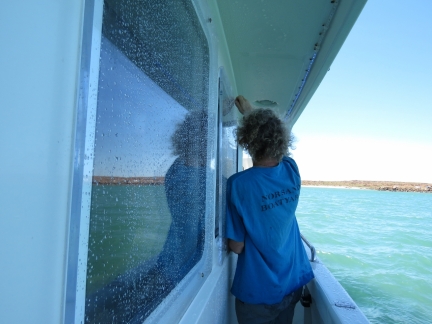 |
Storm plates
Position: 116 41.55, -20 40.10
Large expanses of glass are great for views, but may not be strong enough for survival conditions. Storm plates fit over large windows to protect them. Rugged storm-capable boats really have only two options: very small, very thick windows, or larger windows that need protection at sea. Smaller windows make the boat less liveable, and given the frequeuncy of being at sea and the ease in which storm plates can be installed, the latter approach used by Nordhavn works quite well. We only install ours on longer runs when the weather is less predictable. Here James is installing the storm plates on the starboard windows.
|
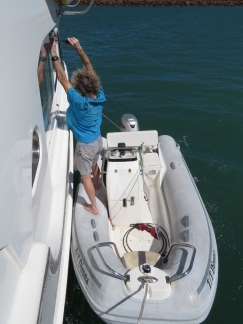 |
Port side storm plates
Position: 116 41.55, -20 40.10
The three windows on the starboard side are easy because we have a walkway there. For the port side, we either have to use a dock or install them from the dinghy. Using the dinghy is about as quick as working on a dock with only a small increased risk of dropping something. Today the water was a little rough, making the job more challenging.
|
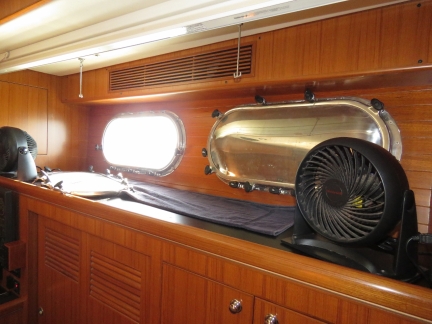 |
Deadlights
Position: 116 41.99, -20 39.71
We also installed the deadlights over the lower windows throughout the boat. Deadlights are metal covers that fit over a porthole to provide additional strength over the glass alone.
|
 |
Bladders
Position: 116 41.56, -20 40.09
The aft fuel bladders ready for filling. We haven’t had them out since the run from Hawaii to the Marquesas Islands.
|
 |
HHBSC dock
Position: 116 41.99, -20 39.71
We landed on the Hampton Harbour Boat and Sailing Club (HHBSC) dock shortly after seven this morning to fuel up and clear customs.
|
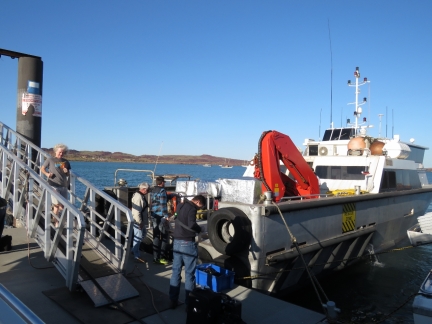 |
Crew transfer
Position: 116 41.99, -20 39.71
The HHBSC dock is the only small craft dock in the area and is heavily-used for commercial activities. A constant stream of commercial vessels came and left while we were there. This boat is taking crew out to a nearby ship for a four-week stint.
|
 |
Pilot
Position: 116 41.99, -20 39.71
This harbour pilot boat was moored near us over the weekend and came by to pick up a pilot this morning.
|
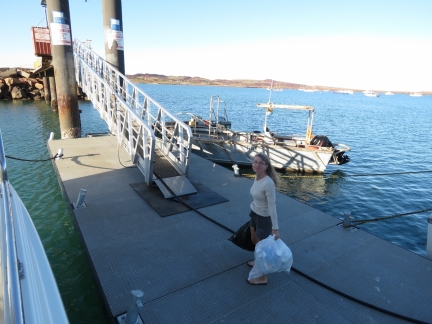 |
Garbage
Position: 116 41.99, -20 39.71
A final garbage run before we depart.
|
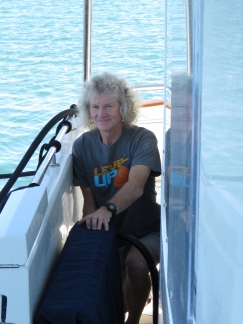 |
Filling the main tanks
Position: 116 41.99, -20 39.71
James filling the main tanks before we fill the bladders. In front of him is our teak cockpit table that we fold down and strap to the walkway when we deploy the cockpit bladders.
|
 |
Filling the aft bladders
Position: 116 41.99, -20 39.71
Filling the two 300-gallon aft bladders. After filling all the bladders, we were carrying 2,587 gallons. With a 200-gallon reserve, we need to make 1.26 nm/gallon to travel the 3,005 miles from here to Rodrigues, Mauritus.
|
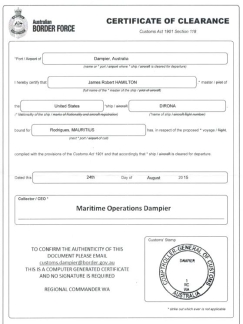 |
Certificate of Clearance
Position: 116 41.99, -20 39.71
The HHBSC dock also is the customs clearance dock. Customs arrived just as we were finishing up the fueling and we were cleared out a half-hour later. At some Australian ports such as Darwin and Broome, you can clear out a day or so before actually departing. In Dampier, you have to leave once you’ve cleared. That was our plan anyway, so not an issue for us.
|
 |
Nor Australis
Position: 116 35.79, -20 36.85
Several anchor-handling tugs and offshore supply vessels like the Nor Australis were anchored in Mermaid Strait as we passed. The Dampier area servers the fairly substantial oil and gas industry in this region of Australia.
|
 |
Cape Sorrel
Position: 116 15.95, -20 28.00
The Australia Customs and Border protection patrol boat Cape Sorrel came up astern of us soon after we’d cleared the Dampier Archipelago. They radiod us and asked for vessel details and our last and next port of call. Once satisfied, they returned back towards Dampier. Australia sure does protect it’s border carefully.
|
 |
Sunset
Position: 116 0.88, -20 25.10
Enjoying our first sunset of the trip. Conditions are wonderfully calm, with winds below 10 and only a light swell. We expect this will hold out for the next five days at least.
|
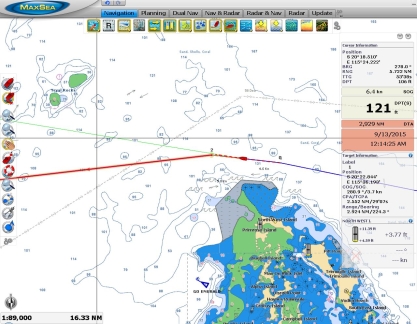 |
Last course change
Position: 115 30.49, -20 19.34
As we round North West Island, at the northern end of the Montebello Islands, we’ll make our final scheduled course change for three weeks until we reach Rodrigues. And it will be our last sighting of land until then as well. It’s night, so we can’t actually see the island, just the navigations lights on it. Offshore gas platforms ring the Montebello Islands. We can see their bright lights way in the distance and are picking up several AIS targets, likely support vessels, moored among the islands.
|
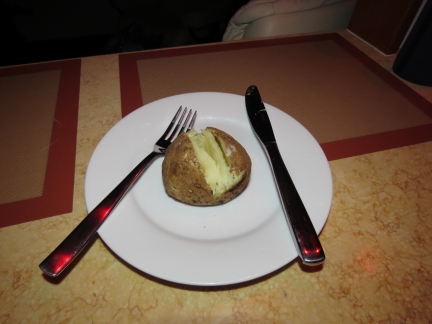 |
Baked potato
Position: 114 57.81, -20 22.61
Jennifer does just one scheduled watch, from 10pm to 5am, and often has a starch craving in the middle of the night. A baked potatoe or plain pasta usually is the cure.
|
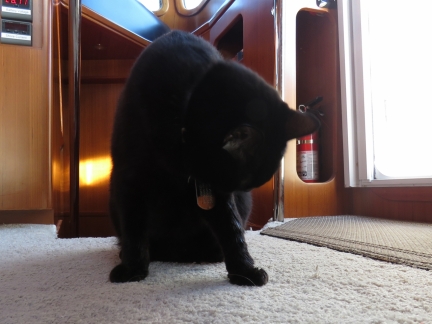 |
Wet paw
Position: 114 27.54, -20 25.95
Spitfire badly wanted outside, so we let him out on a supervised walk. As he passed a scupper on his way from the pilot house to the cockpit, a wave came through and soaked his paw. He let out a howl of indignation and spent about a half-hour cleaning himself up after he came back inside. He’s likely less eager to get outside now.
|
 |
Far Shogun
Position: 114 20.90, -20 26.68
Far Shogun was at anchor in the Port of Dampier when we arrived. The ship was holding position just north of our course this morning, frequently emitting big puffs of black smoke as the dynamic positioning system held the ship in place. We radioed several times to make sure we wouldn’t be too close for whatever operations they had underway, but never received a response. The ship didn’t show up on AIS until we were quite close, but we continued to receive their AIS signal several miles after we’d passed, so likely they turned it on when they saw us.
|
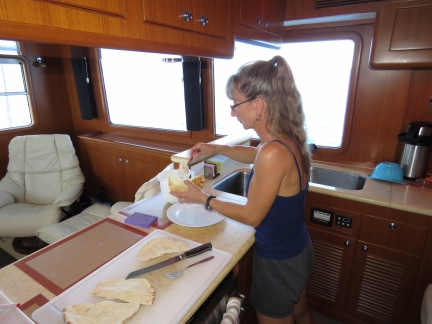 |
Shrimp pitas
Position: 114 2.44, -20 28.71
Shrimp salad in pita pockets for lunch.
|
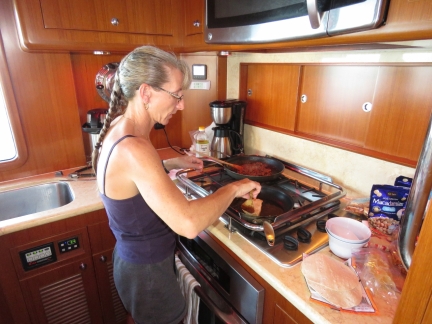 |
Taco night
Position: 113 33.86, -20 31.85
Jennifer frying tortillas for a taco dinner. We don’t actually have a taco night, although we used to have a pizza night. A longstanding tradition in the Hamilton household, dating back to our Toronto days in the late 1980s, was a pizza while watching Monday Night Football.
|
 |
Sunset
Position: 113 29.48, -20 32.34
Our second sunset of the trip. Conditions are even calmer than last night, remeniscent of our Tasman Sea crossing. It won’t last, but we’re sure enjoying it while it does.
|
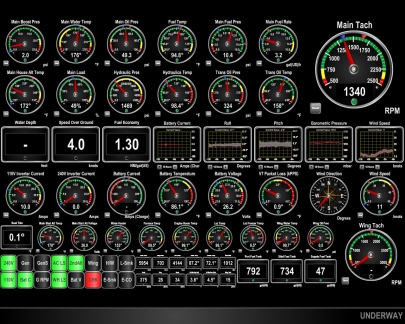 |
Four knots
Position: 112 44.03, -20 37.34
The only problem with the current conditions is we’re often fighting a wicked counter-current. Since we’re running to fuel economy, we have to slow down to reduce fuel burn. We need to attain 1.26 gallons per hour, but nothing makes you nervous about fuel economy like 1,500 miles to the closest shore. So we continue to aim for a little bit better than that and consequently are giving up more speed than needed.
|
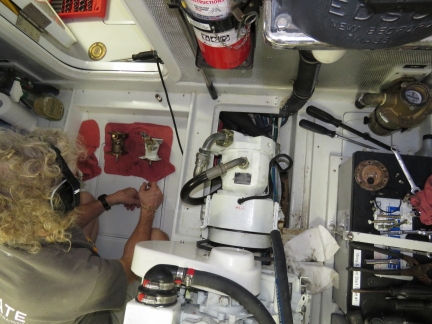 |
Raw water pump
Position: 111 54.66, -20 42.81
As unlikely as it sounds, just as we set off on a 3,005nm trip with all mechanical systems in top operating condition, the wing engine cooling pump water seal failed as we were maneuvering off the fuel dock at Dampier. The wing only is used for anchoring, close-quarters maneuvering and in emergency operations. But in the short run with the leak it had sprayed saltwater everywhere. Even with the motor shut off, it dribbled water. So today James spent a couple of hours to install the spare. The water pump change on these engines and generators is remarkably easy. This one is made a little more challenging in that the hydraulic power take-off (PTO) pump interferes with the removal of the cooling pump. The hydraulic pump driven by the engine PTO extends from the center of the front of the engine in the middle of the photo and the cooling pump mounting position is also at the front of the engine between the hydraulic pump and the batteries further outboard. (Click photo for larger view).
|
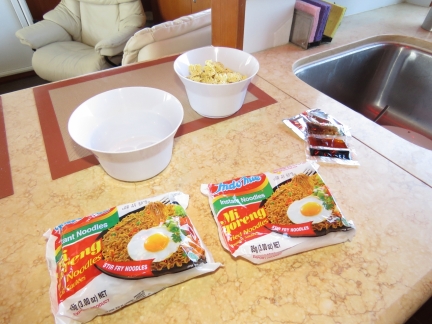 |
Mi Goreng
Position: 111 38.60, -20 44.67
Spicy Mi Goreng fried noodles for lunch.
|
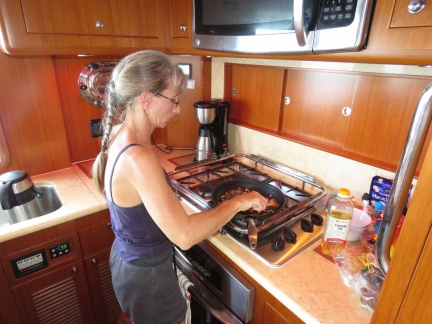 |
Steak and ginger
Position: 111 19.95, -20 46.83
Making beef stir-fried with onions and fresh ginger over rice for dinner.
|
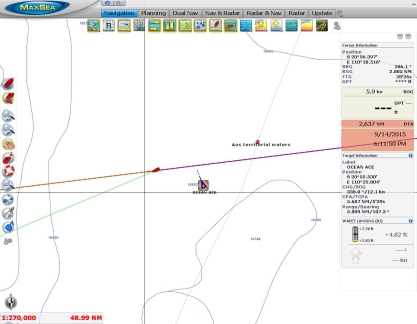 |
Ocean Ace
Position: 110 20.18, -20 53.76
The bulker Ocean Ace passed about 5.5 miles behind us shortly after we exited Australian territorial waters. The ship was en-route from Geraldton, Australia to Jakarta, Indonesia.
|
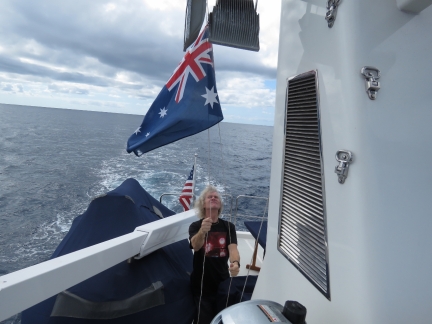 |
Courtesy flag
Position: 109 29.79, -20 59.60
Taking down our Australian courtesy flag as we leave Australian territorial waters. That’s sure been up for a long time. Well, not that particular flag–we went through three others before it. We buy ours from J&S Surplus where a 2ftx3ft flag is only $13. The flags aren’t very durable, but usually will last a couple of months. We also bought one high-quality one in Australia that lasted well.
|

|
Click the travel log icon on the left to see these locations on a map, with the complete log of our cruise.
On the map page, clicking on a camera or text icon will display a picture and/or log entry for that location, and clicking on the smaller icons along the route will display latitude, longitude and other navigation data for that location. And a live map of our current route and most recent log entries always is available at http://mvdirona.com/maps. |
If your comment doesn't show up right away, send us email and we'll dredge it out of the spam filter.

Hello James and Jennifer,
I am following your progress across the Indian Ocean, fascinated, and wish you continued safe travel.
I have a question. My wife Kelly and I are currently in the market for a Nordhavn, having pretty much settled on the brand. We are considering a 55, no 60 is currently in our budget. When you selected the 52, did you consider a 55 or 60, and if so, what factors led you to the 52? A main reason I ask is that it seems most Nordhavn ocean crossings have been aboard models of 47 (52 now) or smaller. Is this a “safer” size for some reason?
Best Wishes,
Darryn and Kelly
Good question on why we got the N52 rather than a larger boat. Generally bigger has more waterline and will be cable of higher displacement speeds (and these boats don’t do anything other than displacement speeds). Bigger often can carry more fuel. And bigger will usually handle sea conditions slightly better and be slightly safer in life threatening conditions. I say slightly safer because even 150′ fish boats are lost to weather each year. Very large 950′ bulkers are lost to weather (and poor maintenance) every year. If the weather is really bad, bigger is nowhere close to removing the risk but it can help. Some small boats are safer than big ones and a strong, well built and well maintained small boat is hard to beat.
We chose the 52 because it was big enough to do all that we wanted and we could afford to operate it and it allowed us to have the financial resources to enjoy ourselves all over the world and not worry that much about the price of fuel in Australia or the failing of some expensive piece of navigational equipment. Smaller boats are usually less expensive, less labor intensive, easier to find moorage for, and capable of nearly everything that a large boat can do. ON maintenance, it’s astounding how surface area we have to wax and cleaning the bottom always leaves me thinking that I would never want a bigger boat.
The Nordhavn N55 and N60 are very similar size boats and, although they are more expensive than a N52, the dollar to space ratio is as good and actually might be better in the N55/N60 series. If we were doing it again, we know for sure we don’t want smaller than our current boat. And, I don’t think we want bigger than a N60. If we doing a new purchase today we would look hard at both the N52 and the N60 — for our tastes the N55 doesn’t have enough outside area and we love spending time in the Cockpit.
Great, good to know.
Thanks so much for taking the time to respond. Enjoying your updates and looking forward to news of your safe arrival in Mauritius!
Safe travels,
Darryn
Just a quick ‘see you’… we’ll be thinking of you on your travels as we embark on ours. All the best Jennifer and James. Hugs, Sue xox
Thanks Sue! Everything is going well and we’re only 889 miles out for Rodrigues now.
Just saw from your update that the back fuel bladders are still full. When do you think you will pump those into the main tanks?
Well timed question. This morning we just passed the “full” tank consumption which is to say we have exactly the space we need to transfer the bladders down into the main tanks. I normally wait a day or so after this point to ensure that there are no mistakes and no overflows or spilled fuel. Can’t afford the loss and it wouldn’t be good for the environment. We’ll do it either tomorrow or the next day.
Hi James,
Thanks for sharing that heavy weather advice. I was wondering about the deadlights. I am unfamiliar with them. Did you have to have them custom made?
Wishing you both safe travels and calm seas.
Stew
The deadlights are a nice feature that comes standard with Nordhavns. I’ve actually talked to one Nordhavn owner that had a portlight blow in from heavy seas so there can be some value in using them at least in really rough water.
They just come with the boat as standard equipment.
Hi James,
Glad your cruise so far is smooth. A couple of questions, if I may:
– looking at the position map it seems as if you are cruising south of what a straight line cruise should be. Is this as a result of Mercator Projection?
– How/When do you use the stabilizers when you cruise?
Best,
Etienne
Hello Etienne. When the boat was new we often ran without stabilizers in protected coastal waters but you really want them on for even light swell in the open ocean. It’s just a lot more comforable. Since the stabilizers take very little power and are very durable we quickly evolved to just leaving them on all the time. Less things get spilled and it’s just more comfortable on the boat with the stabilizers on so, if we are under way, they are on.
We are drivign the great circle route which is the shortest distance between two points on a sphere. On longer routes out beyound 2,000nm, these start to look very distinctly curved on any map projection. However, it is the shortest path so that’s the one we are on.